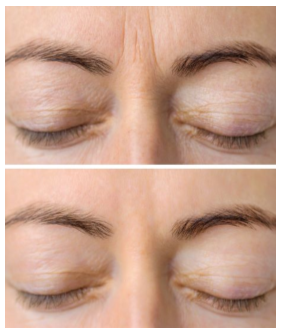Injectables & Wrinkle Treatment

Understanding Types of Treatments for Facial Wrinkles
Prominent forehead creases, brow furrows or eye lines (crow’s feet) produced by specific facial expression muscles repeatedly creasing the skin may be effectively treated by reducing the function of specific facial muscles. The neurotoxins (Botox, Dysport, Xeomin, and Jeuveau) are sterile, purified proteins produced from the bacteria, Clostridium botulinum, in the laboratory.
Neurotoxins injected in small amounts into facial muscles bind to the nerve endings supplying the muscle and prevent nerve impulses from traveling to the muscle. When injected into a muscle, it weakens or paralyzes the muscle around the area injected for a typical period of several months. The resultant weakening or paralyzing effect on the facial muscle temporarily reduces or eliminates previous skin creasing and new skin creasing is avoided. Botox may take several days to have its effect, and the effect typically lasts 3-4 months, in most individuals, before full muscle movement returns. At that point the treatment may be repeated as desired.
Injectable fillers are substances that are used by your physician to replace lost volume in certain areas of your face. When used appropriately they can result in substantial and fairly long-lasting improvement. They are not replacements or alternatives to neurotoxins in that they treat a different set of problems: deeper creases and folds that are not due to muscle activity. FDA-approved fillers are a constantly changing landscape, but some of the common fillers in use today are the following:
Hyaluronic Acids (Juvederm, Restylane, and others). These products are composed of a gel-like substance that is found in our bodies in between the cells. This substance is lost as we age, so one can consider this as replacement therapy in a way. These fillers are soft to the touch and are used in the lips and other areas where a softer product is needed. They do not typically last as long as some of the other fillers.
Calcium Hydroxylapatite (CaHA) microspheres (Radiesse). This product is another naturally occurring compound in our body and has a paste-like consistency. It is used in areas where a thicker, firmer filler is needed. It has a variety of uses ranging from facial augmentation as well as for hand rejuvenation when there is too much tendon show in the hands after volume loss. Most studies have found it to last somewhat longer than the hyaluronic acid products.
Poly-L-Lactic Acid (Sculptra) This product is a synthetic polymer that has long been used in dissolvable suture material. It works in a different manner than the other fillers: it stimulates your body to generate new collagen. It is really intended for deeper injection sites such as the cheek or temple areas and should not be used in the eyelid or lips. It requires multiple injection sessions to reach the goal of correction, whereas most of the other fillers can be used to obtain correction in 1 or 2 sessions.
Fat grafting creates a natural augmentation for the face using your own “filler”. Fat is usually harvested from the abdomen, flanks, or inner thighs; and about one third of the volume remains after the treatment. Fat grafting can be repeated for additional fullness.
What to Expect During and After Treatment
In comparison to typical cosmetic surgical procedures, the office time for these procedures and the subsequent recovery period are minimal. Botulinum toxin therapy typically takes a few minutes to perform, and most patients may return immediately to home or work. Minor local irritation, redness, bruising, or swelling at the injection sites are the most commonly observed side effects, all of which typically abate within a few hours.
Likewise, filler injection therapy can be accomplished with a 5-15 minute procedure. For fillers, it is common to have a topical numbing application prior to injection in the areas of treatment. Some mild irritation, swelling, or bruising at the injection sites is common but can easily be camouflaged with standard make-up if necessary.
Some fillers may be used for fine lines though fine lines are often improved with neuromodulators. Other fillers are better for increasing facial volume. Either one may require more than one treatment session for maximum positive results.